In today’s ever evolving digital environment we are able to enjoy our lives more and more each day. Advancements in software & hardware have enabled us access that we had not dreamed of in the past. Such as: Staying connected everywhere we go with wireless mobile services, High Speed internet access, Streaming Services, Social media upgrades, Advance of digital purchases, contactless order / delivery. Just to name a few!
These advancements are amazing and provide greater accessibility and comfort to our daily lives. For example: At the click of a button we can enjoy various products and food items to be delivered to our homes at the click of a button. Or watch your favorite shows anytime on Netflix, without commercials or being restricted to tune in at certain times.

The modern digital world offers many great possibilities. However, it is extremely important that we understand these digital advancements also provide alternative forms for scam artists to contact us with fraudulent attempts. Staying informed about these new forms of fraudulent activity is the best way that we can protect our digital accounts & finances.
Previously we would see more obvious attempts of a scam Phone call received from a foreign / international Phone Number, with someone on the other end claiming to be from “Air duct cleaning services”. Or perhaps communicating that you had randomly been selected as the winner of a sum of money.. These attempts would be obviously suspicious and often quickly realized as a scam attempt.
Currently we see many advanced forms of contact from scammers, such as: Emails, Text and Calls, which at first glance appear as a legitimate contact from a banking, government, or financial institution. We need to be vigilant when receiving these types of contacts.

Obviously if you do not use the institution’s services these contacts can be safely ignored, blocked and reported. However, for example: If the contact is coming from RBC bank, and you are using RBC’s banking services, these contacts can be fairly convincing at times..
There are a few ways we can identify if it is a legitimate contact sent from RBC bank, or a possible fraudulent attempt from a scammer impersonating RBC. Please view examples below-
- Email contact from an official institution will always have an official email handle or domain name – For example, the contact e-mail may appear as ‘RBC BANK’. This can simply just be the name they have selected for their email in an attempt to appear as RBC.. When investigating the contact email further, we can determine if the contact email address is from an official @rbc.com domain or not. Scam attempts will use personal emails such as: @hotmail.com, @gmail.com etc.
- Institutions will NEVER ask you to confirm your login details – If you receive contact requesting to verify your login info, or have received a link to login via their website: This is a red flag and should be viewed as suspicious! When receiving any type of suspicious requests it is recommended not to reply or end the call right away! Follow up by google searching the institution’s official contact information, and reach out to them directly. They will gladly confirm if the request had come from them directly.
- Ignore and Report – If determined that the request had not come from the institution directly, or you do not recognize the institution contacting you – it is recommended to block and report these contacts.
Unfortunately the elderly, and new arrivals to a new country are at the highest risk in regard to cyber security threats, as they may be unfamiliar with these new methods of digital fraud. The best thing we can do is educate ourselves and our friends and family! For a further detailed description on how we can protect ourselves from cyber security risks, check out Berkeley Universities ‘Top 10 Secure Computing Tips’ – Top 10 Secure Computing Tips

